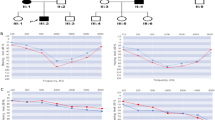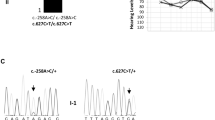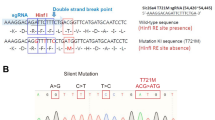Abstract
Two different missense mutations, p.D572N and p.D572H, affecting the same nucleotide and codon of the TMC1 gene were earlier reported to cause autosomal dominant hearing impairment at locus DFNA36 in two North American families. No other dominant mutations of human TMC1 have been published. We ascertained a third North American family segregating autosomal dominant nonsyndromic hearing impairment at the DFNA36 locus. We identified the p.D572N mutation of TMC1 co-segregating with hearing loss in our study family. A comparative haplotype analysis of linked single nucleotide polymorphisms and short tandem repeats in the two families segregating p.D572N was not consistent with a founder effect. These findings can be explained in two ways. Either nucleotide 1714 is a hot spot for mutations or, alternatively, missense mutations at this site confer a specific pathogenic gain-of-function or dominant-negative effect.
Similar content being viewed by others
Introduction
Hearing impairment is a very common sensory disorder, affecting one out of 650 newborns.1 Forty-six genes have been found for nonsyndromic hearing loss, one of which is transmembrane channel-like gene 1 (TMC1). TMC1 mutations cause nonsyndromic autosomal dominant and recessive hearing loss at the DFNA36 and DFNB7/11 loci, respectively. Two mouse mutations have been identified in Tmc1: the dominant Beethoven (Bth) mutation and the recessive deafness (dn) mutation.2, 3 The hearing loss and hair cell loss phenotype of heterozygous Beethoven mice is modified by distinct loci, depending on the genetic background of these mice.4 The gene encodes a transmembrane protein that may be involved in the functional maturation of cochlear hair cells.5 The two known dominant TMC1 mutations, c.1714G>A and c.1714G>C, affect the same nucleotide and are predicted to encode the amino acid missense substitutions p.D572N and p.D572H, respectively.3, 6
In this study, we ascertained a third North American Caucasian family H segregating autosomal dominant hearing loss caused by the c.1714G>A (p.D572N) mutation of TMC1. Recurrent mutations have been reported in several other deafness genes and can be the result of a mutational hot spot, as is the case for mutation W276S in KCNQ4 and mutations in the mitochondrial tRNASer(UCN) gene.7, 8 In other cases, the mutations have a common founder, as has been proven for the GJB2 mutations 35delG and 235delC.9, 10 We investigated the origin of the recurrent TMC1 mutation p.D572N by comparative haplotype analysis of family H and the earlier reported family segregating p.D572N.
Materials and methods
Phenotype analysis
The Caucasian North American family H was ascertained at the House Ear Institute (Los Angeles, CA, USA). Participating family members provided written informed consent. This study was approved by the ethical committee of the House Ear Institute and the National Institute of Health (NIH) Combined Neurosciences IRB (Bethesda, MD, USA). Audiometric examination was performed by measuring the air conduction thresholds at frequencies 250, 500, 1000, 2000, 4000 and 8000 Hz. Family members were considered to be affected if three or more thresholds exceeded the 90th percentile of the International Organization for Standardization (ISO) 7029 normative values for age and gender (ISO, 2001). Unaffected phenotype status was defined by thresholds lower than age- and gender-matched 50th percentile values for all frequencies measured.
Genotype analysis
DNA was extracted from peripheral blood lymphocytes by a standard salting-out procedure.11 A genome-wide scan was performed with a polymorphic set of short tandem repeat (STR) markers spread over the genome. Logarithm of odds (LOD) scores were calculated with Easylinkage (version 4.01, Berlin, Germany)12 assuming autosomal dominant inheritance, with fixed linkage parameters (allele frequency: 0.001, phenocopy rate: 0%, penetrance: 0% for wild type/wild type and 90% for wild type/mutant and mutant/mutant). STR markers were amplified by PCR for genotype analysis on an ABI 3130 automated DNA sequencer (Applied Biosystems, Foster City, CA, USA).
Haplotypes were compared by analysis of STR markers and single nucleotide polymorphisms (SNPs) within and flanking TMC1 (Table 1 and Supplementary Table 1). The frequencies of repeat lengths for STR markers were obtained from the GDB human genome database (www.gdb.org). The allele frequencies of SNPs were obtained from the Hapmap (www.hapmap.org).
All coding and non-coding exons of TMC1 were PCR-amplified and sequenced using an ABI 3130 automated DNA sequencer (Applied Biosystems).
Results
Family H phenotype
Figure 1 shows the pedigree of family H with autosomal dominant inheritance of nonsyndromic, postlingual-onset hearing loss. Fifteen members of the family participated, of which eight were classified as affected. Hearing loss was anamnestically reported to start during the first decade to initially affect the mid and high frequencies, followed by rapid progression to severe-to-profound levels, also affecting the low frequencies. This phenotype is consistent with the phenotype reported for DFNA36.6, 13
Pedigree of family H co-segregating nonsyndromic autosomal dominant hearing loss (filled symbols) with STR markers at the DFNA36 locus. STR haplotypes are shown with the linked haplotype in boxes. In the maternal haplotype of individual III:7, a recombination is present between markers D9S769 and D9S152. Individual IV:6 has been reported as unaffected but carries the linked haplotype, indicating reduced penetrance.
Family H genotype
A genome-wide scan showed linkage to STR markers on chromosome 9q, a region overlapping the DFNA36 locus. The genotypes of additional STR markers confirmed linkage at this locus (Figure 1). One of the unaffected individuals, IV:6, did carry the linked haplotype, indicating reduced penetrance of the hearing loss in the family. Therefore, the maximum two-point LOD score was 1.99 for marker D9S152. The maximal multipoint LOD score was 3.2, indicating significant linkage. DNA sequencing of TMC1 detected heterozygosity for the published missense mutation c.1714G>A in all affected family members and in individual IV:6, but not in other unaffected individuals. This nucleotide change causes the amino acid substitution p.D572N, which had been identified in the original DFNA36 family, LMG128.3 We were unable to detect the mutation either in 118 Belgian control samples or in 159 US Caucasian control samples.
Haplotype comparison of families H and LMG128
To determine whether the p.D572N mutation segregating in families H and LMG128 with mutation 1714G>A was derived from a common founder, we compared their linked haplotypes of STR markers and SNPs (Table 1 and Supplementary Table 1). All of the tested microsatellite markers had different p.D572N-linked alleles between the two families. In addition, four SNPs spanning either side of the mutation also had different linked alleles, whereas all other SNPs were uninformative.
Discussion
In total, three families with hearing loss at locus DFNA36 have been reported, all having a nucleotide change at position 1714 of TMC1. In families LMG128 and H, mutation c.1714G>A is present, whereas in family LMG248, the nucleotide change is c.1714G>C. Families LMG128 and H most likely do not have a common founder, as we found several differences in linked haplotypes of STR markers and SNPs flanking both sides of the mutation. Although this does not rule out a founder effect completely, the proximity (4 kb) of the closest distinguishing SNP to p.D572N suggests that such a founder would quite likely be very ancient.
One individual from the family carries the linked haplotype but does not have hearing loss. The reduced penetrance is remarkable, as it has not been reported in the other DFNA36 families and the affected family members share a rather uniform phenotype.
The observation that all known DFNA36 mutations affect the same TMC1 nucleotide and codon could be explained in different ways. A first hypothesis is that nucleotide 1714 of TMC1 is a hot spot for mutations that arose independently.6 This hypothesis is supported by the observation that the affected nucleotide is located within the hypermutable CpG context.14 A second hypothesis is that both mutations confer a specific gain-of-function or dominant-negative effect. Specific missense mutations at position 572 of the protein cause this effect, leading to dominant inheritance, whereas missense mutations at other positions cause the creation of a function null allele, leading to recessive inheritance. Under both hypotheses, it is clear that amino acid 572 has a critical function in the TMC1 protein.
References
Mehl, A. L. & Thomson, V. The Colorado newborn hearing screening project, 1992–1999: on the threshold of effective population-based universal newborn hearing screening. Pediatrics 109, E7 (2002).
Vreugde, S., Erven, A., Kros, C. J., Marcotti, W., Fuchs, H., Kurima, K. et al. Beethoven, a mouse model for dominant, progressive hearing loss DFNA36. Nat. Genet. 30, 257–258 (2002).
Kurima, K., Peters, L. M., Yang, Y., Riazuddin, S., Ahmed, Z. M., Naz, S. et al. Dominant and recessive deafness caused by mutations of a novel gene, TMC1, required for cochlear hair-cell function. Nat. Genet. 30, 277–284 (2002).
Noguchi, Y., Kurima, K., Makishima, T., De Angelis, M. H., Fuchs, H., Frolenkov, G. et al. Multiple quantitative trait loci modify cochlear hair cell degeneration in the Beethoven (Tmc1Bth) mouse model of progressive hearing loss DFNA36. Genetics 173, 2111–2119 (2006).
Marcotti, W., Erven, A., Johnson, S. L., Steel, K. P. & Kros, C. J. Tmc1 is necessary for normal functional maturation and survival of inner and outer hair cells in the mouse cochlea. J. Physiol. 574, 677–698 (2006).
Kitajiri, S., Makishima, T., Friedman, T. B. & Griffith, A. J. A novel mutation at the DFNA36 hearing loss locus reveals a critical function and potential genotype-phenotype correlation for amino acid-572 of TMC1. Clin. Genet. 71, 148–152 (2007).
Van Camp, G., Coucke, P. J., Akita, J., Fransen, E., Abe, S., De Leenheer, E. M. et al. A mutational hot spot in the KCNQ4 gene responsible for autosomal dominant hearing impairment. Hum. Mutat. 20, 15–19 (2002).
Jin, L., Yang, A., Zhu, Y., Zhao, J., Wang, X., Yang, L. et al. Mitochondrial tRNASer(UCN) gene is the hot spot for mutations associated with aminoglycoside-induced and non-syndromic hearing loss. Biochem. Biophys. Res. Commun. 361, 133–139 (2007).
Van Laer, L., Coucke, P., Mueller, R. F., Caethoven, G., Flothmann, K., Prasad, S. D. et al. A common founder for the 35delG GJB2 gene mutation in connexin 26 hearing impairment. J. Med. Genet. 38, 515–518 (2001).
Yan, D., Park, H. J., Ouyang, X. M., Pandya, A., Doi, K., Erdenetungalag, R. et al. Evidence of a founder effect for the 235delC mutation of GJB2 (connexin 26) in east Asians. Hum. Genet. 114, 44–50 (2003).
Miller, S. A., Dykes, D. D. & Polesky, H. F. A simple salting out procedure for extracting DNA from human nucleated cells. Nucleic Acids Res. 16, 1215 (1988).
Lindner, T. H. & Hoffmann, K. easyLINKAGE: a PERL script for easy and automated two-/multi-point linkage analyses. Bioinformatics 21, 405–407 (2005).
Makishima, T., Kurima, K., Brewer, C. C. & Griffith, A. J. Early onset and rapid progression of dominant nonsyndromic DFNA36 hearing loss. Otol. Neurotol. 25, 714–719 (2004).
Murphy, B. C., Scriver, C. R. & Singh, S. M. CpG methylation accounts for a recurrent mutation (c.1222C>T) in the human PAH gene. Hum. Mutat. 27, 975 (2006).
Acknowledgements
This study was supported by grants from EUROHEAR (LSHG-CT-20054-512063), the Fund for Scientific Research Flanders (FWO-F, Grant G.0138.07), and the NIH intramural research fund Z01-DC-000060-07. Nele Hilgert is a fellow of the Fund for Scientific Research Flanders (FWO-F).
Author information
Authors and Affiliations
Corresponding author
Additional information
Supplementary Information accompanies the paper on Journal of Human Genetics website (http://www.nature.com/jhg)
Supplementary information
Rights and permissions
About this article
Cite this article
Hilgert, N., Monahan, K., Kurima, K. et al. Amino acid 572 in TMC1: hot spot or critical functional residue for dominant mutations causing hearing impairment. J Hum Genet 54, 188–190 (2009). https://doi.org/10.1038/jhg.2009.1
Received:
Revised:
Accepted:
Published:
Issue Date:
DOI: https://doi.org/10.1038/jhg.2009.1
Keywords
This article is cited by
-
A TMC1 (transmembrane channel-like 1) mutation (p.S320R) in a Polish family with hearing impairment
Journal of Applied Genetics (2015)




